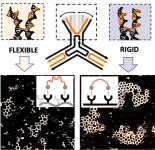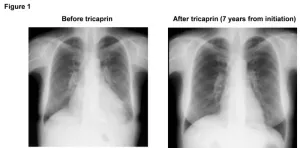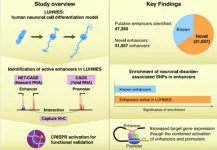(Press-News.org) Jumping workouts could help astronauts prevent the type of cartilage damage they are likely to endure during lengthy missions to Mars and the Moon, a new Johns Hopkins University study suggests.
The research adds to ongoing efforts by space agencies to protect astronauts against deconditioning/getting out of shape due to low gravity, a crucial aspect of their ability to perform spacewalks, handle equipment and repairs, and carry out other physically demanding tasks.
The study, which shows knee cartilage in mice grew healthier following jumping exercises, appears in the journal npj Microgravity.
“Since the next step in human exploration of space is going to Mars and spending long periods of time in permanent bases on the moon, cartilage damage is a really major issue that space agencies need to address despite how very poorly understood it is,” said study author Marco Chiaberge, an astrophysicist at Johns Hopkins University, the Space Telescope Science Institute, and the European Space Agency. “The positive effect we saw in these mice is huge, and the magnitude of it was unexpected. They can basically make their cartilage thicker if they jump. Maybe astronauts could use similar training before their flight as a preventive measure.”
Healthy cartilage is essential for pain-free movement, as it cushions joints and decreases bone friction. But cartilage heals slowly and does not regenerate as fast as other tissue. Prolonged periods of inactivity—whether from bed rest, injury, or space travel—can accelerate cartilage breakdown. Space radiation can also accelerate this effect, and European Space Agency experiments have shown evidence of cartilage degradation in astronauts who spend several months aboard the International Space Station.
“Think about sending somebody on a trip to Mars, they get there and they can't walk because they developed osteoarthritis of the knees or the hips and their joints don't function,” Chiaberge said. “Astronauts also perform spacewalks often. They serviced the Hubble Space Telescope five times, and in the future, they will need to spend more time in space and the Moon, where we will build larger telescopes to explore the universe and where they will need to stay as healthy as possible.”
Previous research has shown that treadmill running may help slow cartilage breakdown in rodents. The new Johns Hopkins study adds to the evidence by demonstrating that jump-based exercise may prevent articular cartilage loss in knees and could actually improve cartilage health.
The researchers found that mice in a nine-week program of reduced movement experienced cartilage thinning and cellular clustering, both early indicators of arthritis. But mice that performed jump training three times a week showed the opposite effect—thicker, healthier cartilage with normal cellular structure.
The study found the mice with reduced movement had a 14% reduction in cartilage thickness, while those in the jump-training group had a 26% increase compared to a control group. Additionally, the jumping mice had 110% thicker cartilage than the reduced activity group.
Jumping also enhanced bone strength. The team found shin bones in the jumping mice had 15% higher mineral density. Trabecular bone—spongy bone tissue that absorbs impact—was significantly thicker and more robust.
“Leg strength is particularly important and most highly impacted by microgravity, so any procedures that can address multiple aspects of muscle deconditioning, and maybe even reduce the two-hour daily exercise requirement in space, would be most welcome,” said author Mark Shelhamer, a professor of otolaryngology at the Johns Hopkins School of Medicine and former NASA Human Research Program Chief Scientist. “The same reasoning applies to bone integrity, including cartilage. There is increasing recognition of the importance of cartilage as a distinct component in bone integrity, and this study contributes to that understanding.”
While more research is needed to confirm whether humans would enjoy the same benefits, the findings offer promising information to protect cartilage and bone structure. Jumping exercises could be included in pre-flight routines to prepare joints for space travel, and specially designed exercise machines could help integrate similar workouts in space.
The study could help scientists explore how jump-based training might not only aid patients with arthritis but also boost cartilage health with generally applicable exercises, said author Chen-Ming Fan, a musculoskeletal biologist at Carnegie Science.
The researchers emphasized the need for further research to determine the ideal exercise volume and frequency for preserving and strengthening cartilage. Future work will also explore whether jump training could help reverse cartilage loss and whether the exercise could help astronauts restrengthen their cartilage and recover damage from space flight.
“Now that we got our first clue that one type of exercise can increase cartilage, which was completely unknown before, we could start looking into other types of cartilage. What about the meniscus? Could it also get thicker?” said Fan, who is also an adjunct professor at Johns Hopkins. “This research could help performance-enhancement studies, rather than just focusing on pathological conditions, and help athletes or virtually anyone interested in doing the right exercises to improve their performance.”
Other authors are Neelima Thottappillil, Anderson Furlanetto, Dylan Odell, Christine Wang, Stephen Hope, Stephen Smee, Joseph Rehfus, Colin Norman, and Aaron W. James of Johns Hopkins; Anna-Maria Liphardt of Universitätsklinikum Erlangen, Friedrich-Alexander-Universität; Anja Niehoff of German Sport University Cologne; and Marc J. Philippon and Johnny Huard of Steadman Philippon Research Institute.
This research was supported by a Space@Hopkins Seed Grant and by the Carnegie Science Endowment fund.
END
Jumping workouts could help astronauts on the moon and Mars, study in mice suggests
First-of-a-kind study hints at likely way to counter cartilage damage in long space journeys
2025-02-13
ELSE PRESS RELEASES FROM THIS DATE:
Guardian molecule keeps cells on track – new perspectives for the treatment of liver cancer
2025-02-13
A guardian molecule ensures that liver cells do not lose their identity. This has been discovered by researchers from the German Cancer Research Center (DKFZ), the Hector Institute für Translational Brain Research (HITBR), and from the European Molecular Biology Laboratory (EMBL). The discovery is of great interest for cancer medicine because a change of identity of cells has come into focus as a fundamental principle of carcinogenesis for several years. The Heidelberg researchers were able to show ...
Solar-powered device captures carbon dioxide from air to make sustainable fuel
2025-02-13
Researchers have developed a reactor that pulls carbon dioxide directly from the air and converts it into sustainable fuel, using sunlight as the power source.
The researchers, from the University of Cambridge, say their solar-powered reactor could be used to make fuel to power cars and planes, or the many chemicals and pharmaceuticals products we rely on. It could also be used to generate fuel in remote or off-grid locations.
Unlike most carbon capture technologies, the reactor developed by the Cambridge researchers does not require fossil-fuel-based power, or the transport and storage of carbon dioxide, but instead converts atmospheric CO2 into something useful using sunlight. ...
Bacteria evolved to help neighboring cells after death, new research reveals
2025-02-13
Darwin’s theory of natural selection provides an explanation for why organisms develop traits that help them survive and reproduce.
Because of this, death is often seen as a failure rather than a process shaped by evolution.
When organisms die, their molecules need to be broken down for reuse by other living things.
Such recycling of nutrients is necessary for new life to grow.
Now a study led by Professor Martin Cann of ...
Lack of discussion drives traditional gender roles in parenthood
2025-02-13
Conversations about parental duties continue to be led by mothers, even if both parents earn the same amount of money, finds a new study by a UCL researcher.
A new study by Dr Clare Stovell (IOE, UCL’s Faculty of Education & Society), published in the Journal of Family Studies, highlights how a lack of discussion between parents about important choices such as parental leave, work and childcare is perpetuating traditional gender roles.
The study found that women usually lead the conversations and there is little discussion about the man’s work schedule, even in cases where the woman earns as much or more than her partner.
Dr Stovell said: “These interviews ...
Scientists discover mechanism driving molecular network formation
2025-02-13
Covalent bonding is a widely understood phenomenon that joins the atoms of a molecule by a shared electron pair. But in nature, patterns of molecules can also be connected through weaker, more dynamic forces that give rise to supramolecular networks. These can self-assemble from an initial molecular cluster, or crystal, and grow into large, stable architectures.
Supramolecular networks are essential for maintaining the structure and function of biological systems. For example, to ‘eat’, cells rely ...
Comprehensive global study shows pesticides are major contributor to biodiversity crisis
2025-02-13
Pesticides are causing overwhelming negative effects on hundreds of species of microbes, fungi, plants, insects, fish, birds and mammals that they are not intended to harm – and globally their use is a major contributor to the biodiversity crisis.
That is the finding of the first study assessing the impacts of pesticides across all types of species in land and water habitats, carried out by an international research team that included the UK Centre for Ecology & Hydrology (UKCEH) and the University of Sussex.
Multiple negative impacts
The scientists analysed over 1,700 existing lab and field studies of the impacts of 471 different ...
A simple supplement improves survival in patients with a new type of heart disease
2025-02-13
Osaka, Japan – Heart transplant is a scary and serious surgery with high cost, but for patients with heart failure it can be the only option for cure. Now, however, a multi-institutional research team led by Osaka University has found that simply taking a supplement might be all that is needed for certain patients with heart failure to recover – no surgery needed.
In a study published in Nature Cardiovascular Research, the research team found that tricaprin, a natural supplement, can improve long-term survival and recovery from heart failure in patients with triglyceride deposit cardiomyovasculopathy ...
Uncovering novel transcriptional enhancers in neuronal development and neuropsychiatric disorders
2025-02-13
Neuropsychiatric disorders are becoming increasingly prevalent. Given their complex and multifactorial pathogenesis, there is an urgent need for effective and targeted therapies that can improve patients’ quality of life. Genome-wide association studies (GWASs) have identified various genetic alterations that contribute to the development and progression of neuropsychiatric disorders, ranging from mild dyslexia to more severe conditions such as schizophrenia.
While thousands of single nucleotide polymorphisms (SNPs)—changes in a single nucleotide position in the DNA—have been associated with neurological ...
IR Sant Pau study reveals immune system’s crucial role in ALS at cellular level
2025-02-13
A team of researchers from the Sant Pau Research Institute (IR Sant Pau) has published a study in the Journal of Neuroinflammation that, for the first time, examines in depth the role of the peripheral immune system in amyotrophic lateral sclerosis (ALS) at the single-cell level. Their findings suggest that immune system cells—particularly two subpopulations of Natural Killer (NK) cells—may play a crucial part in the development and progression of this neurodegenerative disease.
ALS is a condition that causes the progressive degeneration of motor neurones, leading to a loss of muscle function and, eventually, affecting ...
Brain rhythms can predict seizure risk of Alzheimer’s disease patients, study finds
2025-02-13
A UCLA Health research team has identified changes in brain rhythms that indicate seizure activity in Alzheimer’s patients.
The findings, published in Brain Communications, build on UCLA neurologist and senior author Dr. Keith Vossel’s pioneering work that first linked silent epileptic activity to cognitive decline in Alzheimer’s disease.
Vossel’s previous studies showed that silent seizures, detected through overnight electroencephalography (EEG) and one-hour magnetoencephalography (MEG), occur in more than 40% of Alzheimer’s patients—beyond the 20% who experience overt seizures. His research has demonstrated ...
LAST 30 PRESS RELEASES:
Air pollution exposure and birth weight
Obstructive sleep apnea risk and mental health conditions among older adults
How talking slows eye movements behind the wheel
The Ceramic Society of Japan’s Oxoate Ceramics Research Association launches new international book project
Heart-brain connection: international study reveals the role of the vagus nerve in keeping the heart young
Researchers identify Rb1 as a predictive biomarker for a new therapeutic strategy in some breast cancers
Survey reveals ethical gaps slowing AI adoption in pediatric surgery
Stimulant ADHD medications work differently than thought
AI overestimates how smart people are, according to HSE economists
HSE researchers create genome-wide map of quadruplexes
Scientists boost cell "powerhouses" to burn more calories
Automatic label checking: The missing step in making reliable medical AI
Low daily alcohol intake linked to 50% heightened mouth cancer risk in India
American Meteorological Society announces Rick Spinrad as 2026 President-Elect
Biomass-based carbon capture spotlighted in newly released global climate webinar recording
Illuminating invisible nano pollutants: advanced bioimaging tracks the full journey of emerging nanoscale contaminants in living systems
How does age affect recovery from spinal cord injury?
Novel AI tool offers prognosis for patients with head and neck cancer
Fathers’ microplastic exposure tied to their children’s metabolic problems
Research validates laboratory model for studying high-grade serous ovarian cancer
SIR 2026 delivers transformative breakthroughs in minimally invasive medicine to improve patient care
Stem Cell Reports most downloaded papers of 2025 highlight the breadth and impact of stem cell research
Oxford-led study estimates NHS spends around 3% of its primary and secondary care budget on the health impacts of heat and cold in England
A researcher’s long quest leads to a smart composite breakthrough
Urban wild bees act as “microbial sensors” of city health.
New study finds where you live affects recovery after a hip fracture
Forecasting the impact of fully automated vehicle adoption on US road traffic injuries
Alcohol-related hospitalizations from 2016 to 2022
Semaglutide and hospitalizations in patients with obesity and established cardiovascular disease
Researchers ‘listen in’ to embryo-mother interactions during implantation using a culture system replicating the womb lining
[Press-News.org] Jumping workouts could help astronauts on the moon and Mars, study in mice suggestsFirst-of-a-kind study hints at likely way to counter cartilage damage in long space journeys








